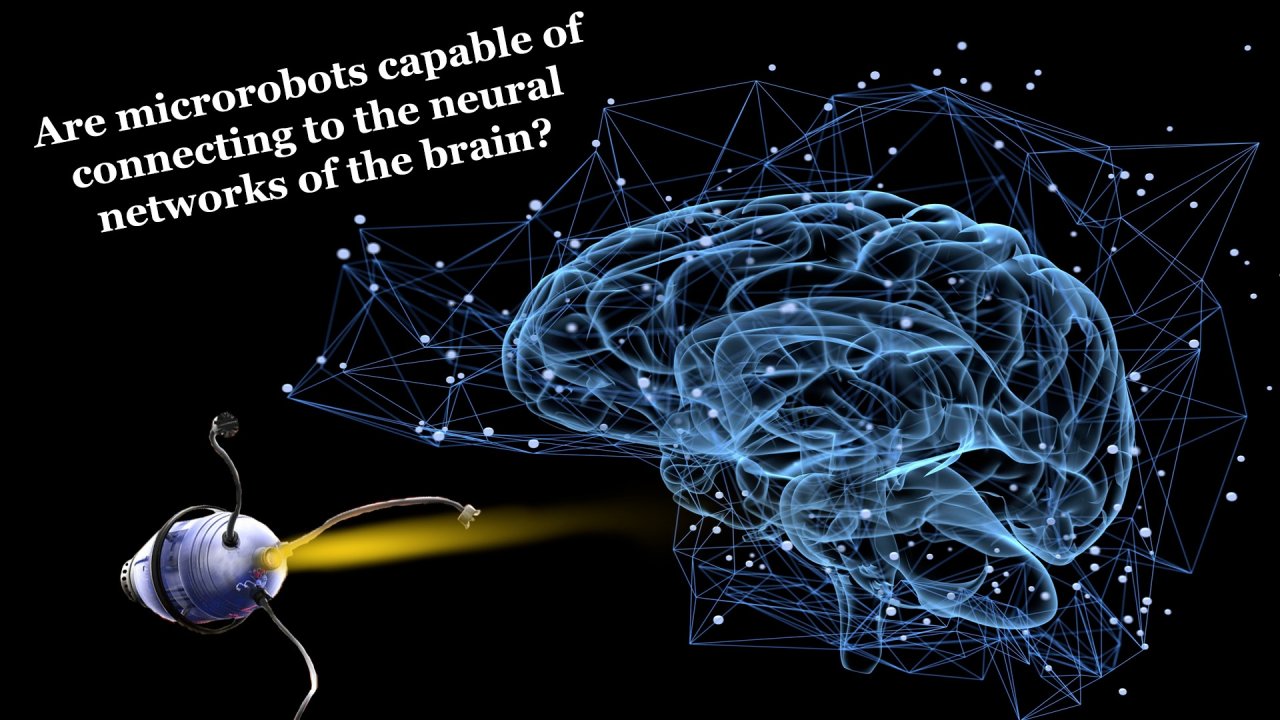Are the microrobots able to connect to the neural networks of the brain?

On the website of the popular science magazine «Хайтек+»2, an article titled “A micro robot has been created that can connect to the neural networks of the brain, as in the Matrix» by Georgy Golovanov was published on March 31, 2023. This publication claims that a team of researchers from South Korea has developed a micro robot that through electrochemistry is able to connect to the neural networks of the hippocampus (the structure of the brain responsible mainly for memory consolidation). Thus, a micro robot transmits and reads electrical signals through axons. Moreover, this micro robot is also capable of forming new neural networks. The technology was developed in order to implement cell therapy and subsequent introduction into regenerative medicine. However, the researchers said that its potential is much wider.

Picture 1: screenshot of the article
(Source: HI-TECH+)
Our team decided to find out how reliable are the achievements within the framework of the described technology and weather during the integration of micro robots they could connect to the neural networks of the hippocampus and perform a regenerative function.
The operating principles of microrobots, tested on laboratory mice
The article was published by Vancouver Lim on the EurekAlert! portal. It says that when creating a micro robot, superparamagnetic iron oxide nanoparticles are attached to the hippocampus cells of a laboratory mouse. This makes it possible to produce a three-dimensional spherical neurobot. The author, referring to a press release from the Korean Institute of Brain Research, argues that, thanks to this technology, a robot controlled by external magnetic fields has the ability to move in the desired direction, and to be more precise, to reach the hippocampus. During the experiment, using immunofluorescence staining, it was revealed that both cells in the microbot and cells in a section of hippocampal tissue are able to structurally bind through neurites (nerve axons).
Besides, the researchers confirmed that the nerve cells delivered by the microbot can functionally form cells and the neural networks inside a section of laboratory mice‘ hippocampal tissue. Consequently, scientists have the opportunity to influence nervous activity.

Picture 2: screenshot of the article
(Source: EurekAlert!)
The Advantages of connecting micro robots to neural networks of the brain:
– Restoration of damaged neural connections or replenishment of lost brain functions, restoration of its operability
– The possibility of targeted drug supplies to certain areas of the brain which can help in the treatment of diseases such as Parkinson’s disease or epilepsy. Georgy Golovanov in his article “A micro robot has been created that can connect to the neural networks of the brain, as in the Matrix» mentioned that Miniature devices will attack abnormal cells, constantly allocating the necessary doses of the drugs. The same principle can be used to fight bacterial infections. In this way the technology can be effective in the following cases:
– assistance in restoring brain function after a stroke by maintaining or restoring connections between damaged neurons
– accurate diagnosis and monitoring of brain condition, which will help in the early detection and treatment of diseases such as brain tumors. In the long term, as the author of the article published in HI-TECH+ notes that such opportunities can bring cancer immunotherapy to an unprecedented new level of effectiveness

Picture3: screenshot of the article
(Source: HI-TECH+)
– improving brain function and increasing its potential, which will allow us to solve more complex cognitive tasks. However, there are many contradictions in this regard, primarily related to Bioethics.
Potential challenges and risks:
Dmitry Ivliev in his scientific article “Artificial Intelligence and problems of ethics” notes that with the development of artificial intelligence, the potential risks of widespread use of AI in social and public life are also highlighted and classified. For example, concerns are caused by unforeseen mistakes which were made during the development and machine learning period. Also, the massive loss of initial, primary and natural human skills. Today the development of AI does not guarantee that humanity will not come to an absolute dependence on computers, including in the field of decision-making. At the moment, all kinds of the developments potentially suitable for human use are primarily coordinated with the bioethical committee which examines issues of ethics and morality.

Picture 4: screenshot of the article
(Source: Law and Practice)
The ethical risks of “brain management” technologies are presented in Anders Corr’s article “Ethical Risks of Chinese ‘Brain Management’ Technology.”

Picture 5: screenshot of the article
(Source: “The epoch times”)
Special attention is paid to the opinions of bioethics experts Marcello Ienck (University of Basel in Switzerland) and Pim Hazelager (Radboud University Nijmegen in the Netherlands): In their opinion, brain control technologies can be used to violate the privacy and freedom of action of an individual. “Neuroaccessibility” and “brain hacking”, as well as illegal access and manipulation of neural information, according to the researchers, are serious risks to human neurosecurity for instance privacy and freedom of action. The leading personality qualities are under attack: consciousness, perception, thinking, peach, judgment and memory. Jenka and Hazelager noted that “the misuse of neural devices for cybercrime purposes threatens not only the physical safety of users, but also affects their behavior and changes their self-identification as a person.” Thus, it can be stated that the ethical risks of the technology in question have not been sufficiently studied due to its rapid development.
In order to better understand the advantages and disadvantages of the technology, we talked with Albina Lebedeva, Candidate of Biological Sciences and Senior Researcher at the Research Institute of Neuroscience at Lobachevsky University. First of all, we were interested in the question: Can micro robots be used to improve cognitive abilities such as memory, attention and the information processing speed?
I believe that such technologies should primarily be used in cases related to human health. Is it necessary to create such technologies so that everyone can enhance their cognitive functions, which are already within normal medical parameters? There are many ethical questions related to bioethics. Why artificially create superhumans with improved capabilities? I believe that it is necessary to follow the path of helping people who really suffer from cognitive impairments due to medical conditions, — noted the expert.
Albina Lebedeva also pointed out the potential risks of using this technology:
Rejection of a microrobot by the immune system is very possible. For this reason, biocompatibility technologies are being developed for some long-term electrode groups that will be implanted into the neural networks of the brain or hippocampus. Because when electronic groups are implanted into an animal’s brain, they start being overgrown with real cells within 2-3 weeks, making it impossible to record anything. In terms of the immune system, of course, microinflammation can begin, and in some cases, significant inflammation can occur if non-sterile components are used. However, when it comes to a solid brain, the immune system of the whole body will not react, only the immune system of the brain will try to dispose of foreign components. Therefore, technologies for biocompatible components are necessary. Scientists are actively advancing in this direction, — she added.
Albina Lebedeva also pointed out the potential risks of using this technology:
Rejection of a micro robot by the immune system is very possible. For this reason, biocompatibility technologies are being developed for some long-term electrode groups that will be implanted into the neural networks of the brain or hippocampus. Because if you implant electronic groups into an animal’s brain, after 2-3 weeks they begin to overgrow with real cells, as a result of which it is no longer possible to write anything down. In terms of the immune system, of course, microinflammation can begin, and in some cases, significant inflammation if non-sterile components are used. But if we talk about the whole brain, then when we implant electrodes, the immune system of the whole body will not react, only the immune system of the brain will try to dispose of foreign components. Therefore, technologies of biocompatible components are needed. Scientists are actively moving in this direction, — she added.
The technology of micro robots capable of penetrating the neural networks of the hippocampus, as noted by the author of the article “Magnetic micro-robot will deliver neurons to the brain” Alexey Kozlov, is at the stage of continuous improvement by scientists in order to ensure high accuracy and low traumatic manipulation of cells. The robot must be placed with exceptional accuracy in a physiological environment, including in the smallest areas of the target tissue. In the future, the author assures, scientists will be able to apply the technology to a wider class of tasks.

Picture 6: screenshot of the article
(Source: “N + 1”)
Conclusion
In addition, the development of the technology of micro robots capable of connecting to the neural networks of the brain is a significant advance in the medical and scientific fields. As noted above, such micro-robots can be used for various medical procedures, such as precise drug delivery, diagnosis and treatment of brain diseases, as well as for research in the field of neuroscience.
Connecting micro robots to the neural networks of the brain will allow doctors and scientists to more accurately influence brain activity, which will make it possible to develop new methods of treating diseases related to the brain. However, it is impossible not to note the ethical risks arising from the development of technology.
Besides, our expert Albina Lebedeva notes, in the future such technologies can be used to expand the human brain:
At the moment, there is a similar actively developing technology related to stem cells. Researchers strive to ensure that artificially implanted stem cells are expressed into the desired cell type, for example, glial cells or muscle cells of conditional stem cells. However, despite the fact that such technologies are in active development, no breakthrough results have yet been presented. A micro robot that will grow neural networks is possible just in combination with such stem cells or with cell cultures that have directed growth combined with micro robots that control this growth. So far, this is my flight of fantasies related to the available experience. We have a group that deals with the directed growth of cells, cell cultures, and they plan to implant these cell cultures with directed growth into the brain – such technology, with good results, would also help with neurodegenerative diseases and injuries. But it takes time to develop such technologies.
Authors: Alina Kalashnikova, Arina Gorshenkova, Anastasia Zakharova, Alyona Manina, Daria Nazarova